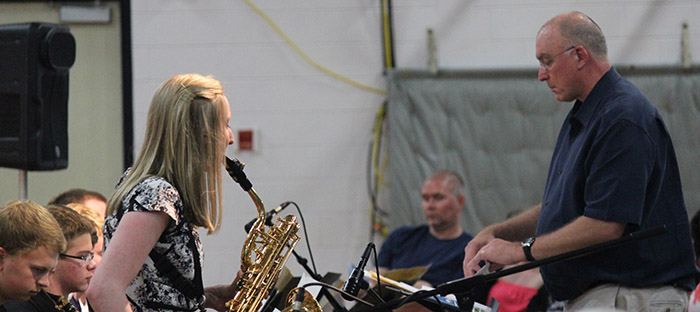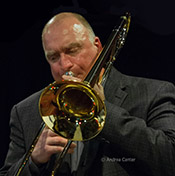
Jazz festivals are terrific opportunities for bands to travel, perform, and bond. The best festivals provide a high-quality performance experience along with insightful teaching. Whether the festival is competitive or not, the band will be playing for judges or clinicians tasked with listening critically and offering comments and suggestions for improvement. Today I’d like to suggest some“best practices” for jazz festival participation, intended to help your band make a positive musical statement whether the festival is competitive or not.
1. Choose Unique Repertoire
An exceptional festival performance begins with exceptional planning and preparation. Festival judges and clinicians often spend very long days listening to many bands. After the fourth time hearing the latest Adele or Pharrell Williams arrangement (or the latest version of “Satin Doll”), fatigue sets in very easily! A fresh set list gets the attention of judges and clinicians immediately, and forces them to take notice.
What makes a program unique? For starters, leave the pop arrangements at home. It is fine to perform the latest pop hits at a hometown concert, but the limited time and increased focus at a festival demands a more sophisticated program. Exposing students to classic jazz tunes (yes, like “Satin Doll!”!) is important, but strive to locate arrangements that are different from those that others are likely to be performing. Play a “head chart” that the band learns by ear. Relatively simple arrangements can be played using no music and it makes for a very different performance experience. If the players are up to it, encourage student writers! There is no better way for a student to learn the craft than to have their work performed and critiqued, and there is no better way for a band to create a unique program than to create the music themselves.
2. Maintain a Professional Stage Presence
The band should take the stage, find their seats, and be ready to play in as orderly a way as possible. Rhythm section players should be coached to make equipment adjustments as efficiently as they can – and make sure bass players and guitar players have all necessary cables. Nothing kills a groove like waiting for 10 minutes while the drummer adjusts stands and the saxes argue about who sits where.
During the performance, have soloists play in front of the band rather than in place. Ideally they will be able to do this without music but having a music stand out front is OK, too. Playing in front of the band makes the soloists easier to hear, and looks better to the audience. It also gives them a little extra encouragement to practice. If moving from their place in the ensemble is impossible, at the very least make sure they are standing in place during solos. This rule applies to everyone except trumpets (who are already standing), pianists (one Jerry Lee Lewis was enough!), and of course drummers.
3. Tune to an Instrument – NOT to a Tuner
There is certainly a place and a time to use a tuner. The place is most often a practice room and the time is during individual practice time. While it may seem more efficient to flash a tuner in front of each student in the band and allow the arrows to tell them to push in or pull out, it does nothing to help them truly listen. Intonation is not a “set it and forget it” skill, and the tuner flash encourages this kind of thinking.
It goes back to planning and preparation. True listening skills take time to develop, and if a band is tuning in this way by the time a festival rolls around it tells me that there has been no work done in the preparation period to teach students how to listen carefully and play in tune. It is of course OK to use a tuner for reference in rehearsal, but do not depend on it. Teaching students to adjust their tuning using their ears and not their eyes will take a little longer, but the long term results are well worth it.
4. Provide Bound Scores with Permission from Publishers
Judges want to be able to follow scores and most festivals require directors to provide copies for every judge or clinician. Most publishers are more than happy to allow copying for this purpose. All directors need to do is ask, and this can usually be accomplished with a quick email. Respecting copyright is something that we should all be modeling as teachers, and this is a very easy thing to do.
Having the scores bound (a simple staple in the corner will do) with the pages in the correct order is a real help. Judges often want to reference specific bar numbers in comments, or want to check the score for performance accuracy if they hear something that sounds amiss. Providing scores that are clean, easy to follow, and LEGAL allows the judge or clinician to focus on listening and music rather than finding their place in the score.

5. Don’t Overstay Your Welcome
Most festivals run on a fairly tight schedule. Keeping your program within the allotted time shows respect for the festival host, the judges and clinicians, and the other performing ensembles. Festivals are long days even when everything runs on time, and when even one band runs overtime it creates more work for everyone.
It goes back to planning and preparation. While your program does not need to be planned down to the second, you should have your soloists and solo lengths planned in advance. While I love a good jam session as much as anyone, a festival performance is not the time for open-ended solos. Many of the great solos we study are short statements that are made within the context of a larger performance. Plan things out accordingly. In addition to programming, getting on and off stage efficiently (see #2 above) will also help a great deal in this regard.
Most of these ideas are simple common sense, and apply to jazz and concert festival performances alike. If you choose your repertoire carefully, and prepare the band with attention to musical details, your festival performance will be a success. Please feel free to contact me if I can be a resource to you in any way.
 Dean Sorenson is Associate Professor and the Director of Jazz Studies at the University of Minnesota as well as a prolific and highly sought-after composer, arranger, trombonist, educator, and clinician. Dean’s latest project is Colors of the Soul, a CD of original music for sexet. His most recent book is First Place for Jazz, a new and innovative method for beginning jazz players published by the Neil A. Kjos Music Company. He is frequently featured at festivals and conventions around the country and abroad, and maintains a full schedule of concert and recording dates as a Yamaha performing artist. For more information please visit www.deansorensonmusic.com.
Dean Sorenson is Associate Professor and the Director of Jazz Studies at the University of Minnesota as well as a prolific and highly sought-after composer, arranger, trombonist, educator, and clinician. Dean’s latest project is Colors of the Soul, a CD of original music for sexet. His most recent book is First Place for Jazz, a new and innovative method for beginning jazz players published by the Neil A. Kjos Music Company. He is frequently featured at festivals and conventions around the country and abroad, and maintains a full schedule of concert and recording dates as a Yamaha performing artist. For more information please visit www.deansorensonmusic.com.